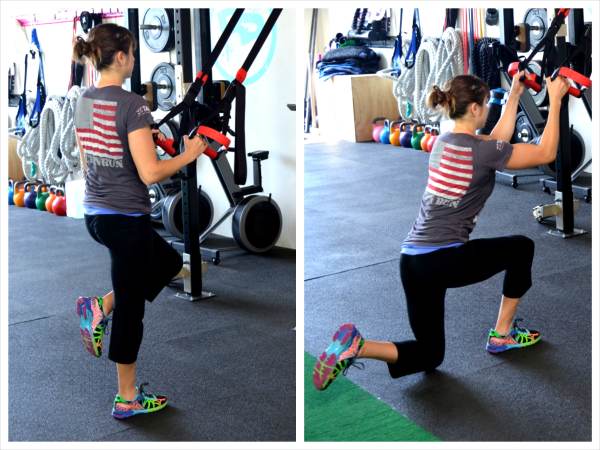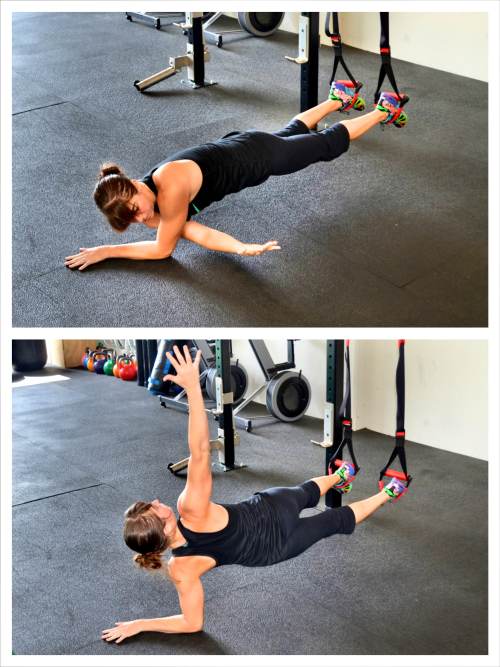WARM UP
Stretch and Roll Out:
Calves
Hamstrings
Quads
Groin
Hips/Glutes
Chest/Back/Lats
WORKOUT
Complete 5 rounds of Front Squats or Goblet Squats following the work/rest ratio below. Then rest up to 2 minutes before moving on to the supplemental circuit. Complete 3-5 rounds of the circuit resting as necessary between exercises and rounds. Do not rest longer than 1 minute though between rounds.
SQUAT CHALLENGE:
1 Minute Front/Goblet Squat
1 Minute Rest
CIRCUIT:
8-15 reps per side Airborne Lunge
10-15 reps per side Low To High Woodchoppers
10-20 reps Jumps For Height
8-15 reps per side Plank with Rotational Reach
COOL DOWN
Stretch and Roll Out:
Calves
Hamstrings
Quads
Groin
Hips/Glutes
Chest/Back/Lats
NOTES:
Pick as heavy a weight as you can handle for the Front or Goblet Squats. You can use a barbell, sandbag or kettlebell(s). Make sure that you can keep moving quickly the entire minute with the weight you choose; however, choose a weight that challenges you. Rest only 1 minute and then repeat. Try to increase the weight you use a little every single time you complete the workout.
With the supplemental circuit, you can do slightly lighter weights and higher reps or work heavier and lower the repetitions. Just choose a rep range and weight that challenges you!
EXERCISE DESCRIPTIONS:
Front or Goblet Squat – To do the Goblet or Front Squat with a kettlebell, take one kettlebell and turn it upside down, holding it on the bell. Set your feet between hip-width to shoulder-width apart. Keep the kettlebell in at your chest. Draw your belly button in toward your spine. Sit your butt back and keep your weight in your heels as you squat down. Keep your chest up and don’t let your back round forward. Sink your butt down as low as you can, keeping your heels on the ground. Then, driving through your heels, come back to standing. Do not lean or rock forward as you stand up. Come all the way up and squeeze your glutes at the top then sink back down. You may also do a double racked kettlebell front squat to make the weight heavier if you don’t have a single bell heavy enough. You can do front squat with a barbell or sandbag instead if no kettlebell is available. (Goblet KB Squat shown below. And Racked Squat below that.)


Airborne Lunge – Beginners will start with the Single Leg Lunge. To do the Single Leg Lunge, hold a strap in each hand and step back so that there is tension in the straps. Then stand on one foot and bend the other knee bringing your foot up toward your butt. You want to drop the knee of the back leg down to the ground without touching your foot down. Sit your butt back and hinge over, dropping that back knee down to the ground. You want to make sure you are sitting back and driving through that standing heel. Do not rock forward and come up onto your toes. Also, make sure you don’t “swing” back on the straps. You want that knee to be over your ankle/foot. Touch your knee down then drive through your heel to come back up to standing. Squeeze your glutes at the top. Use the suspension trainer to help you balance and get back up, but do not turn this into an upper body exercise. Use your arms only as needed! Complete all reps on one side before switching to the other leg. Beginners may not be able to go all the way down and touch their knee to the ground. Start with the range of motion you can control while feeling your glutes work. Advanced exercisers may want to slow down the tempo to make this move harder or even hold only one suspension trainer strap.

They can also do the full Airborne Lunge. To do the Airborne Lunge, stand on your right foot and bend your left knee, bringing your heel back up toward your butt. Then bend your right knee and sit back into your right heel as you lunge down, dropping your left knee to the ground. Do not touch the left foot down when you drop the knee to the ground. Do not reach the left knee back too far when you lunge down. Keep it just a little behind your right foot so that you are almost slightly squatting. Lean forward as needed to counterbalance but do not round forward. To come back to standing, drive up through your right heel and straighten the leg. Complete all reps on one side before switching. Make sure you engage your core and keep your standing heel on the ground at all times. Also, make sure you feel this move in the glute of your standing leg.

Low To High Woodchoppers – Place a band around a low anchor point. Grab the handle of the band in both hands and stand with your feet about shoulder-width apart. Your side will be to the anchor point. Step away from the anchor point so that there is tension in the band even at the end range of motion. Then pivot your feet and bend your knees to reach the handle down outside the knee closest to the anchor point. Your arms should be straight and your chest should be up and there should be tension on the band. Do not round your back to reach lower. Bend your knees and bring the hands outside your knee. Then bring your arms and the band up and across your body as you stand up and pivot toward the opposite shoulder. You should end reaching the other way with your arms reaching up and out at about shoulder height. Do not reach to high up as you reach across. Then control the band back down and across as you pivot and bend your knees. Move in a slow and controlled fashion back down. Do not let the band pull you. Complete all reps to one side before switching. (BOTTOM PICTURE! Can also mix things up with a high to low as well though.)

Jumps For Height – Stand with your feet between hip-width and shoulder-width apart. Perform a shallow squat and explode as high off the ground as possible, reaching overhead and extending your body. Do not squat too low. If you drop too low in a squat, you will actually reduce your power. Beginners may need to rest between each rep; however, that doesn’t mean landing with your legs straight. You should never land with your legs completely locked. Bend your knees to help you absorb the impact of landing.To make the move harder, jump up and sink right back into the squat to repeat as quickly as possible. Really focus on a soft landing and then exploding quickly into as high a jump as you can.

Plank with Rotational Reach – Set up in the high plank position on your hands and knees (beginner) or toes (advanced). Set your feet wider apart to create a more stable base. Then reach one hand under your armpit and toward the far wall. You aren’t just reaching under your armpit to pat yourself on the back. You want to really reach toward the wall. As you reach, make sure your hips stay down. Then pivot open, rotating into a Side Plank as you reach your hand up toward the ceiling. You will reach the hand that reached under your armpit up toward the ceiling, keeping your hips up as you move into a Side Plank. Then reach the hand back down and under your armpit, rotating your hips back down toward the ground and into the Front Plank position. Repeat. Complete all reps on one side before switching and reaching the other way. Do not let your butt go up in the air or your hips sag toward the ground as you reach.

The Plank with Rotational Reach can also be done in the Suspension Trainer (the move in the trainer is almost a hybrid of the Plank and Side Plank with Rotational Reach). However, using the Suspension Trainer makes this move very advanced. Do not add in the trainer until you’ve mastered the movement from the ground.
